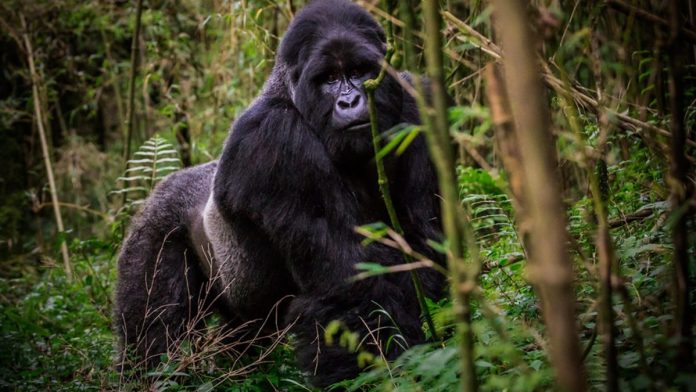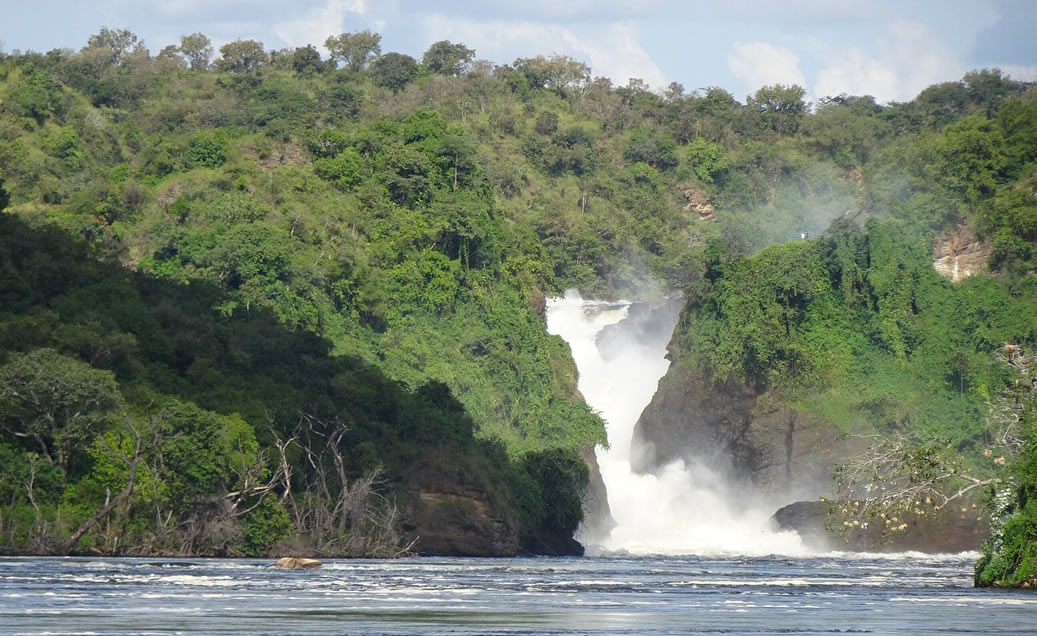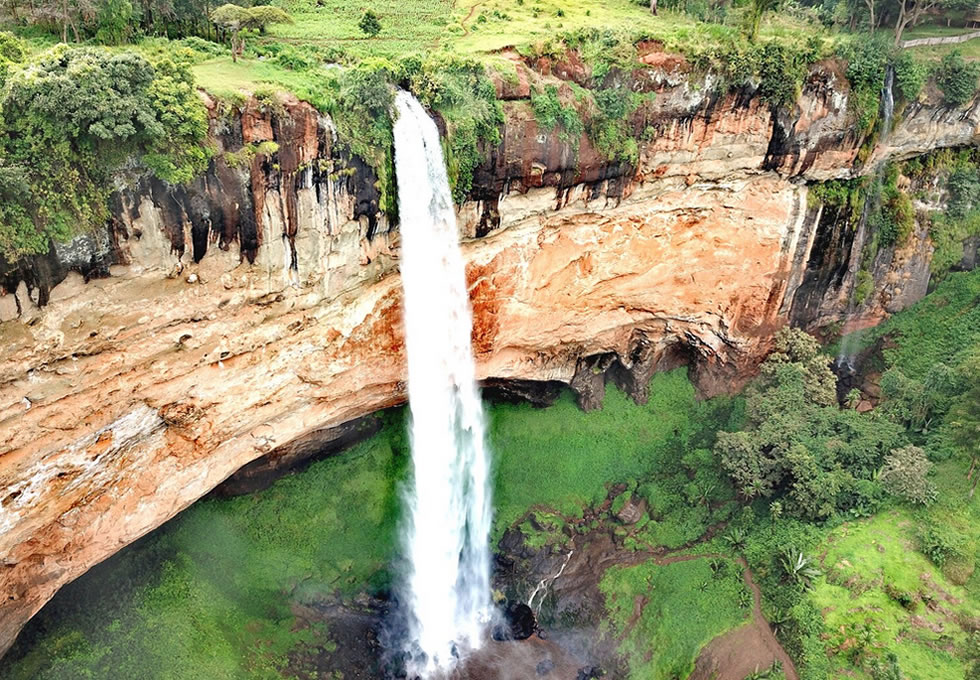There are lots of safari experiences that you can enjoy in Uganda. Some of these are rare experiences that you will not find elsewhere in the world. If you are looking to exploring our amazing country, here are the best 5 wildlife safari experiences that you should not miss while on holiday in Uganda;
1. Gorilla Trekking
Uganda is one of only three countries in Africa where mountain gorillas still move freely. There are about 880 mountain gorillas in the whole world and half of them are found in Uganda in the national parks of Bwindi and Mgahinga Park. These mountain gorillas are not found anywhere else in the world, except the neighboring areas of Parc de Volcanoes National Park in Rwanda, and Virunga National Park in Congo. This largest primate in the world is not found in any Zoo but only in the heart of Africa. Uganda is a home to over half of the Mountain Gorillas in the world with 480. Gorilla tracking is Uganda’s number one attraction and the major activity carried out in Bwindi Impenetrable Forest and this is one of the reasons it was named among the top 5 tourist destination 2017 by CNN.
Many people are interested in tracking the habituated families of the gorillas in the four sectors of Buhoma and Nkuringo being the best interesting gorilla tracking area, Ruhija and Rushaga spending 1 or 4 hours with a Mountain Gorilla Family and these sectors are found in the Bwindi Impenetrable forest. All families have unique behaviors and characteristics, if you have enough time and resources you can track more than one group during your gorilla safari. Under Mgahinga, there is only one group of Gorillas (Nyakagezi group). The tracking starts in the morning with well- informed and knowledgeable professional guides or park rangers to provide information to the trackers. You can also spend 4 hours with a gorilla family on an all-day trek during the Gorilla Habituation Experience costing 1,500 USD.
A maximum of 8 people is allowed to track each gorilla family at any given time in order to conserve their natural habitat and keep them safe from infections. The duration of the trek depends on the family allocated in each sector. Tracking requires a permit to each person interested in the activity. Permits are purchased from Uganda Wildlife Authority and a prior booking is highly recommended before the tracking day, each permit costs $600. The activity requires physical fitness since it is a bit tiresome when moving in the forest, steep slopes and valleys. More so, the length of tracking depends on the Mountain Gorillas’ location simply because they always move in search for food like any other living mammals.
Equipment needed for tracking include; light clothes, water proof cameras, packed lunch, enough drinking water, surgical masks for wearing while in the presence of gorillas. While participating in this activity in the forest, you will hear the sound of birds, monkeys and other mammals.
2. Bird Watching
With the thick rain forests, Uganda as a pearl of Africa has been regarded as the birders’ paradise due to its increasing list of bird species. Almost in every Uganda’s tourism destination is fully occupied with different bird species. The country boasts of over 1037 bird recorded species, about 60 % of the total bird species on the African Continent. These include both tropical and savanna species with the former reaching their eastern limit of their territory. Some of these species are migratory only coming to Uganda to breed and then go back later after breeding for example the grey headed gull. If you are interested in bird watching, you are recommended to surely travel with your camera and Binoculars because you might find out new species to add on your birds list. Some of the most exciting bird spots include Bwindi Impenetrable Forest, Queen Elizabeth National Park with the highest number of birds for any single destination on the continent; about 607 recorded bird species.
Other destinations include; Kibale Forest National Park, Murchison Falls National Park, game reserves, Mabira Forest, Mabamba swamp, Botanical gardens in Entebbe and so many other places across the country including sanctuaries.
3. Lion Tracking
In Uganda, lions are mainly found in Queen Elizabeth National Park and Kidepo Valley National Park. These animals are quite sensitive to the environment. The warming world has made the ground a little hotter and therefore uncomfortable for the lions which spend a lot of time resting thus climbing up and resting in the branches helps them cool off. In an area of low prey density, lions can range within 40 sq km and where the animals of prey are even fewer; the lions can expand their territorial range as big as 400 sq km.
Through the use of radio tracking devices, lions are followed every day; like today, yesterday and tomorrow. This helps to know where every other group is located with respect to the distance from the community land where they can face challenges. The collars have batteries and are electronically configured to certain frequencies with which the park rangers use the GPS system to track the lions.
Lion tracking is not like any other game viewing activity; it’s a research. So for the research to go on right, a limited number of participants are permitted to engage in the lion tracking in Queen Elizabeth national park. Also a limited number helps to heighten your experience during the lion tracking activity. As a small group, you can all get a chance to capture clear pictures. Every participant can get a chance to see the lion before it gets scared away by a lot of noise from the many excited tourists, if at all they could be allowed.
The Lion Tracking is either done in the morning or afternoon and can last between 1 hour to four hours per session. The researchers monitor lions that were put on radio-collars and monitor their movements, territories, risky encounters, and, particularly, their incursions into conflict hot zones where they face the danger of meeting up with people and their livestock.
During the process of tracking, the number of these mammals being tracked can grow without prior warning, mainly resulting from an individual or several lions joining the former group. It is therefore advisable to first note the number of lions being tracked to avoid being confused with the new ones joining the group.
Lion tracking Research is limited to a few number of tourists hence one has to book in advance so as to participate in this exceptional experience in Queen Elizabeth National Park. The cost of Lion tracking permit is $150 and space is always limited because you will be heading with the Researchers on a game drive.
4. Rhino Tracking
There are two types of Rhinos in Uganda that is the Black and White Rhinos. The white rhinos are not surely white and neither are black rhinos really black. Two Rhinos are found in the Entebbe Zoo and the rest are under the protected area of the Ugandan wild life Authority that is; the Ziwa Rhino Sanctuary being watched all day every day. The sanctuary ensures that the second largest land mammals are protected very well.
Ziwa Rhino Sanctuary is a large sprawling wildlife reserve on the way to Murchison Falls National Park. Here you can trek Rhinos on foot and get close up for some great photo opportunities as you are accompanied by Rangers who can take you on this unique trek but give your insight into the daily lives of the Rhinos. The Sanctuary is a conservation and Preservation Project with the intent of restocking Murchison Falls National Park with them.
From the big 5, Rhinos mourn for the death of their family member. On top of all, Rhinos have poor vision and will sometimes attack trees and rocks by accident. However, their hearing and sense of smell are excellent. Their head is the heaviest part on their body that is why they eat only short grass. Their skin is 3 inches thick. They have a small family known as a ‘crash’. They consume up to 150 kilo per day and drink 60 to 80 liters of water in order to sustain their three tone weight.
5. Cheetah Safaris
The cheetahs are one of the rare animals that can hardly be seen in any national park but in Uganda, in the most remote national park that can’t easily be accessed either that is Kidepo National Park. The Cheetahs are elusive animals that belong to the cat family and frequent sighting is expected to boost the popularity of Kidepo as a true part of the remaining wilderness globally. Cheetahs are among the key tourist attraction but they are also categorized among the endangered species.
Some years ago there were a lot of fears that the cheetahs might have been extinct from kidepo valley national park but reports have it that they are spotted in the park though not very oftenly. There were reports from the Uganda wildlife that there about only 20 cheetahs in Kidepo valley national park. therefore something must be done to protect them and their habitat to avoid more extinction there are several non government organizations implementing conservation programs to reduce the poaching activities and over use of animal habitats the best time for viewing cheetahs and other big cats is before sunrise and at sunsets.
It can reach speeds of 70 mph. Unlike other cats, the cheetah has a leaner body, longer legs, and has been referred to as the “greyhound” of the cats. It is not an aggressive animal, using flight versus fight. With its weak jaws and small teeth, the price it paid for speed, it cannot fight larger predators to protect its kills or young.
Sightings that have increased every now and then have hope to wildlife conservation that the situation is not as it was thought, with the cheetah number in Uganda currently estimated at 20. It is becoming common to encounter cheetahs. In December of 2018, tourists encountered 6 cheetahs.










